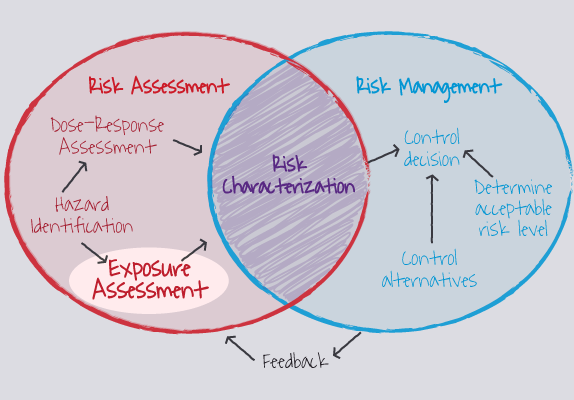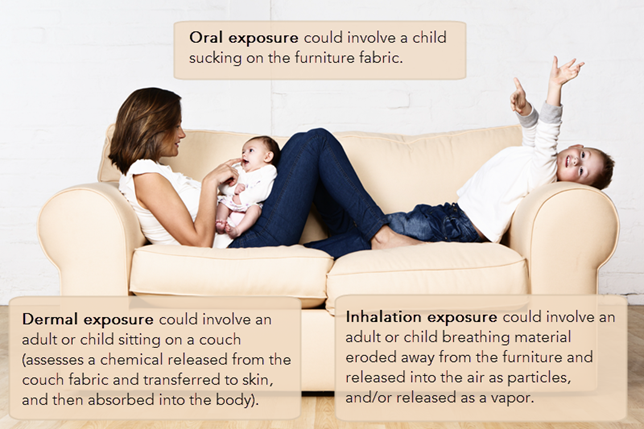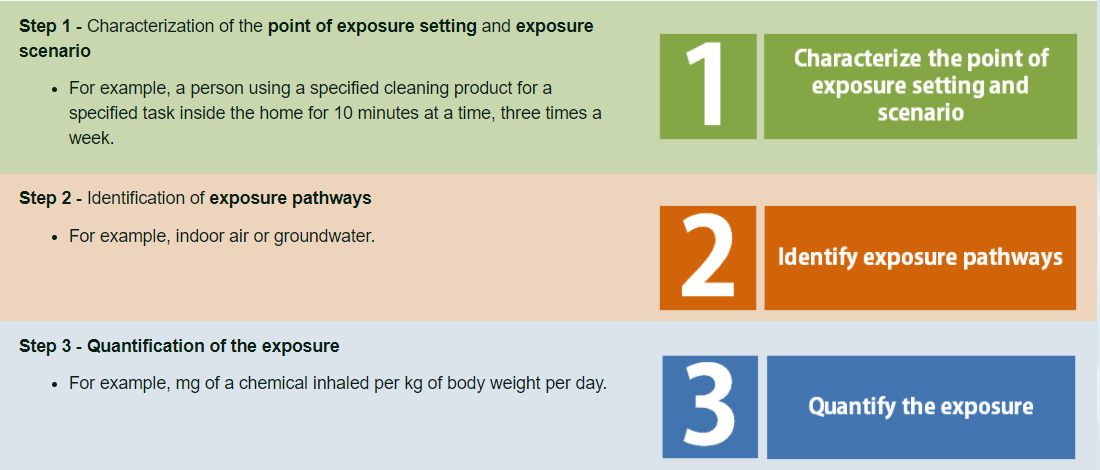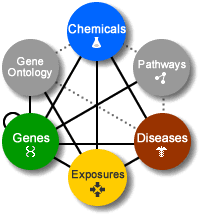Exposure Assessment
|
No Exposure = No Risk
An expression used in toxicology is "no exposure = no risk." Exposure assessment is a key step in the risk assessment process because without an exposure, even the most toxic chemical does not present a threat. Our understanding of potential exposures to chemicals has grown significantly since approximately 1980. For example, research has identified previously "missing" sources and pathways of potential indoor air exposures such as chemicals from consumer products or elsewhere that end up in household dust. Environmental contaminants are analyzed according to their releases, movement and fate in the environment, and the exposed populations. Consumer products and pharmaceuticals are analyzed in terms of reasonably foreseeable potential exposures. |
Figure 1. Exposure assessment as a component of risk assessment
(Image Source: ORAU, ©) |
Sources of Exposure
Everyday life can involve a person being exposed to mixtures of hundreds of chemicals. Examples of documented non-occupational sources include:
Figure 2 highlights potential exposures from a chemical used in furniture fabric.
Everyday life can involve a person being exposed to mixtures of hundreds of chemicals. Examples of documented non-occupational sources include:
- Consumer products (perhaps 20 or more during a day).
- Clothing.
- Residential and other water.
- Indoor and outdoor air.
- Food and food packaging.
- Beverages.
- Toys.
- Furniture.
- Carpeting, paint, and other building materials.
- Tobacco smoke.
- Household dust containing chemicals from consumer products.
- Outdoor soil and soil tracked indoors.
Figure 2 highlights potential exposures from a chemical used in furniture fabric.
Figure 2. Exposure to a chemical used in furniture textiles
(Image Source: Adapted from U.S. National Academy Press publication and iStock Photos, ©)
(Image Source: Adapted from U.S. National Academy Press publication and iStock Photos, ©)
Figure 3 illustrates some of the types of possible consumer exposures from a hand dishwashing product.
Figure 3. The many uses and types of exposures for a dishwashing product
(Image Source: Adapted from iStock Photos, ©)
(Image Source: Adapted from iStock Photos, ©)
Other residential sources of chemicals can come from household air and water. For example, chemicals in air can deposit on, absorb into, or adsorb (Adsorption occurs when molecules of a gas, liquid, or dissolved solid adhere to a surface and create a thin film around it) onto household materials (such as carpets and foods and food packaging), which can lead to dermal and oral exposures. When chemicals are confined to indoor spaces and not diluted in outdoor air, there can be large differences in indoor versus outdoor levels of a chemical.
Figure 4 illustrates some other residential exposures to chemicals via water.
Figure 4 illustrates some other residential exposures to chemicals via water.
Figure 4. Water is a household source of chemicals
(Data Source: American Water Works Association Research Foundation, "Residential End Users of Water," 1999.
Learn more at EPA WaterSense.
Image Source: Adapted from iStock Photos, ©)
(Data Source: American Water Works Association Research Foundation, "Residential End Users of Water," 1999.
Learn more at EPA WaterSense.
Image Source: Adapted from iStock Photos, ©)
Exposure Pathways
The route a substance takes from its source (where it began) to its endpoint (where it ends), and how people can come into contact with (or be exposed to) it is defined as an exposure pathway.
An exposure pathway has five parts:
(Source: ATSDR Glossary)
Process of Exposure Assessment
Exposure assessment is a three-step process:
The route a substance takes from its source (where it began) to its endpoint (where it ends), and how people can come into contact with (or be exposed to) it is defined as an exposure pathway.
An exposure pathway has five parts:
- A source of exposure, such as using a consumer product for a household task or a chemical spilled from a truck onto a highway.
- An environmental media and transport mechanism, such as movement through the indoor or outdoor air or groundwater.
- A point of exposure, such as a person's house or a private well.
- A route of exposure — eating, drinking, breathing, or touching.
- A receptor population — a person or group of people potentially or actually exposed.
(Source: ATSDR Glossary)
Process of Exposure Assessment
Exposure assessment is a three-step process:
The main variables in the exposure assessment are:
Considerations for Environmental Exposure
For an environmental exposure, the risk assessor would look at the physical environment and the potentially exposed populations. The physical environment may include considerations about climate, vegetation, soil type, groundwater and surface water. Populations that may be exposed as the result of chemicals that migrate from the site of pollution are also considered.
Subpopulations may be at greater risk due to a higher level of exposure or because they have increased sensitivity. Examples include infants, the elderly, pregnant women, and those with chronic illness.
Pollutants may be transported away from the source and may be physically, chemically, or biologically transformed. They may also accumulate in various materials. Assessment of the chemical fate requires knowledge of many factors, including:
Use of Exposure Models
Because actual measurements of exposures are often not available, exposure models may be used. For example:
Information Sources on Chemical Exposures and Health
- Exposed populations.
- Types of substances.
- Single substance or mixture of substances.
- Frequency and duration of exposure.
- Pathways and types of exposure.
Considerations for Environmental Exposure
For an environmental exposure, the risk assessor would look at the physical environment and the potentially exposed populations. The physical environment may include considerations about climate, vegetation, soil type, groundwater and surface water. Populations that may be exposed as the result of chemicals that migrate from the site of pollution are also considered.
Subpopulations may be at greater risk due to a higher level of exposure or because they have increased sensitivity. Examples include infants, the elderly, pregnant women, and those with chronic illness.
Pollutants may be transported away from the source and may be physically, chemically, or biologically transformed. They may also accumulate in various materials. Assessment of the chemical fate requires knowledge of many factors, including:
- Organic carbon and water partitioning at equilibrium (Koc).
- Chemical partitioning between soil and water (Kd).
- Partitioning between air and water (Henry's Law Constant).
- Solubility constants.
- Vapor pressures.
- Partitioning between water and octanol (Kow).
- Bioconcentration factors.
Use of Exposure Models
Because actual measurements of exposures are often not available, exposure models may be used. For example:
- In air quality studies, chemical emission and air dispersion models are used to predict the air concentrations to downwind residents.
- Residential wells downstream from a site may not currently show signs of contamination. They may become contaminated in the future as chemicals in the groundwater migrate to the well site.
Information Sources on Chemical Exposures and Health
|
The future of exposure assessment promises to involve more information and more approaches.
Find out more information about:
|
Figure 5. Topics covered by CTD
(Image Source: Davis AP, Grondin CJ, Johnson RJ, Sciaky D, Wiegers J, Wiegers TC, Mattingly CJ The Comparative Toxicogenomics Database: update 2021. Nucleic Acids Res. 2020 Oct 17.) |
Considerations when Reading About a New Exposure Study
When reading about a new exposure study, there are several questions you can consider to critically evaluate studies about everyday chemical exposures.
- Is the study published in a peer-reviewed journal?
- Are there other publications that lend or do not lend support to the current research, or is this study possibly the first of its kind that suggests an emerging issue for regulators, chemical companies, consumer product manufacturers, and others to consider?
- In addition to scientific journal publications, is there information available from government or other Web sites that provides perspectives about the exposures and potential risks?
- How was the study conducted? For example, is it a preliminary or "pilot" study involving a small number of people who were studied, and did the participants represent a narrow or broad, wide range of the types of potentially affected consumers?
- Did the study use household products/materials or food to which some consumers are likely to be exposed? If yes, are there geographical or other limitations that should be noted by the authors such as the products or food being likely to be sold only in one country or region of the world?
- Did the study try to approach "reasonably foreseeable" consumer exposure conditions?
- Is there a known or reasonably foreseeable association between these types of exposures and human adverse effects?







